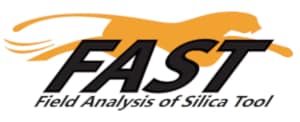Mining Product: FAST - Field Analysis of Silica Tool
Original creation date: September 2018
Authors: E Cauda, L Chubb, J Britton, J Fritz, G Cole
Version: 1.1.0.2
NIOSHTIC2 Number: 20063169
NIOSH [2021]. FAST - Field Analysis of Silica Tool software (v1.1.0). U.S. Centers for Disease Control and Prevention, National Institute for Occupational Safety and Health, DHHS (NIOSH) Publication No. 2021-118 (revised 12/2024), https://doi.org/10.26616/NIOSHPUB2021118revised122024.
Tip for upgrading from the Beta version. To ensure no loss of data, export existing databases before installing FAST v1.0.8. The full instructions for importing and exporting databases can be found in the FAST help guide.
Respirable crystalline silica (RCS) exposure occurs in many industries and the potential health effects of RCS have been well-documented. Monitoring is an essential part of any RCS exposure control plan but the timeliness of data from the lab and the cumulative cost of analysis may limit the extent and the effectiveness of the monitoring process. Field-based monitoring procedures offer a supplement to sample analysis completed by an off-site laboratory. By eliminating the time spent transporting samples and waiting for laboratory results, results are available the same or next day to allow operators to make decisions regarding controls. This enhances the ability to collect data more effectively, enables better control over potential exposures, and protects worker health.
The FAST (Field Analysis of Silica Tool) software processes raw Fourier transform infrared (FTIR) data from field-based instruments and calculates an RCS mass and concentration estimate for each sample. The results can contribute to decision-making to decrease worker exposure to RCS. Field-based monitoring and FAST can be used by anyone with an interest in evaluating RCS exposure but it is primarily intended for industrial hygienists and other workers with health and safety responsibilities, specifically within the mining industry (although workers in other industries will also find it useful). No specialized training in analytical techniques is necessary.
Important Note for FAST users: FAST is designed to work in concert with an easily implemented monitoring approach developed by NIOSH which uses portable FTIR analyzers and dust sampling cassettes at the mine site. As detailed in the software guide, RCS results from this initial release of FAST are accurate if a sample is collected in a coal mine. Choosing a commodity prefixed with the type "other" means that no adjustments are made for other minerals that might be present in addition to crystalline silica.
Therefore, for samples collected in mines other than coal, the results should be considered as approximations. The possible presence of other minerals may decrease the accuracy of the quantification model, and the true result may be greater or less than the approximation. Future releases of FAST will offer improved accuracy for commodity types besides coal.
Review this list of hardware and software requirements for field-based respirable crystalline silica monitoring.
References for published research supporting expansion of FAST to other commodities include:
- Evaluating the use of a field-based silica monitoring approach with dust from copper mines
- A comparison of respirable crystalline silica concentration measurements using a direct-on-filter Fourier transform infrared (FT-IR) transmission method versus a traditional laboratory X-ray diffraction method
Installation instructions:
- Download and unzip the installer to a local folder.
- Open the Installer folder and run setup.exe.
| Revision Date | Revisions | Citation of Revision |
| June, 2021 (Original) | ||
| December, 2024 | Version 1.1.0 includes updates/fixes for importing formatted data files and enhanced app security. | NIOSH [2021]. FAST - Field Analysis of Silica Tool software (v1.1.0). U.S. Centers for Disease Control and Prevention, National Institute for Occupational Safety and Health, DHHS (NIOSH) Publication No. 2021-118 (revised 12/2024), https://doi.org/10.26616/NIOSHPUB2021118revised122024. |

Version: 1.1.0.2
NIOSHTIC2 Number: 20063169
NIOSH [2021]. FAST - Field Analysis of Silica Tool software (v1.1.0). U.S. Centers for Disease Control and Prevention, National Institute for Occupational Safety and Health, DHHS (NIOSH) Publication No. 2021-118 (revised 12/2024), https://doi.org/10.26616/NIOSHPUB2021118revised122024.